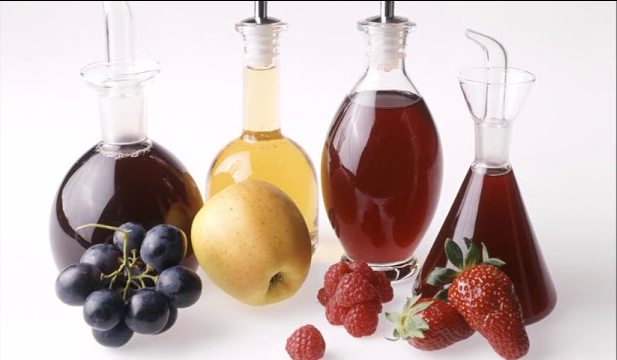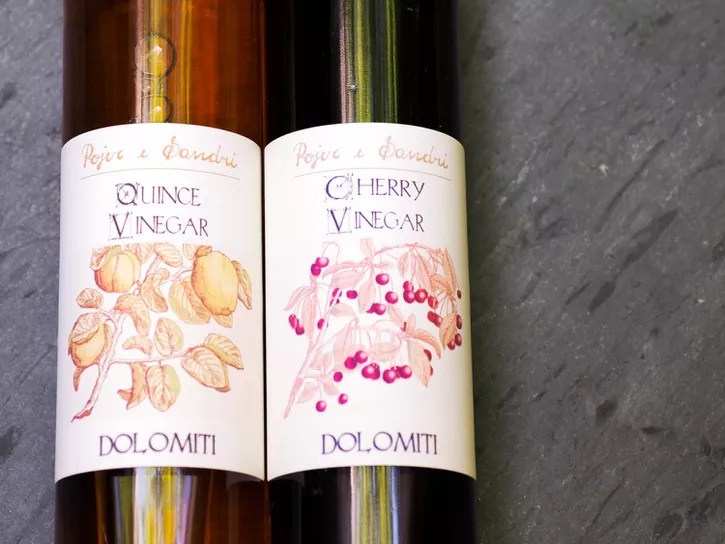Guide to honey vinegar
Take our unique "Learn how to make honey vinegar" course. The rare vinegar sought after by epicureans!
Training to become a master in the art of making honey vinegar.

When you hear the word "vinegar", does it bring to mind rows of cheap bottles on a supermarket shelf?
If so, you're not alone, but you're also missing out.
These vinegars are perfect for marinades, the occasional homemade dressing or cleaning stains from your carpet, but there's also a vast world of complex and deeply flavoursome artisanal vinegars that are well worth discovering.
Used correctly, whether in marinades, dressings, sauces, cocktails or desserts, high quality vinegars have the potential to transform your kitchen.
They can enhance salty flavours, intensify sweetness, reduce saltiness, balance fatty flavours and reduce heat.
That said, cooking with vinegar is a learning process.
If you use too much acid, you risk overpowering the other ingredients; if you use too little, you risk ending up with a dull dish.
And if you start with the wrong product, you risk getting the flavours you want to promote completely wrong.
The most important guideline?
A good vinegar should be delicious - a sip should make your mouth water and leave you wanting more, not explode your palate to the point where you don't want to taste anything else.

Around the world, vinegar is generally defined as a solution containing at least 4 % of acetic acid.
It can be made from a wide range of basic ingredients, but the underlying process is essentially the same.
Sugar-rich base ingredients - whether complex carbohydrates from starchy foods such as rice, potatoes and barley, or simple sugars from apples, grapes and honey - are first fermented into an alcoholic product using yeast.
It could stop there, and in some cases it does, producing drinks such as wine, beer and mead.
The second stage consists of transforming these alcoholic substances into vinegar (including common spirits such as whisky, although it is extremely rare to find such vinegars in specialist shops).
This time, instead of yeast, the micro-organism in question is acetobacter, sometimes also known as acetic acid bacteria.
It eats up the alcohol, as well as the available oxygen, and converts it into acetic acid, the compound responsible for vinegar's sharp, sour flavour.
There you have it, the vinegar done!
Traditional methods usually involve slow fermentations that take several months or even years to complete.
Industrial vinegars, on the other hand, can be made in a matter of hours or days using equipment such as stainless steel vats called aceators, which pump oxygen into the liquid to encourage faster fermentation into vinegar.
This accelerated version of vinegar making tends to eliminate the aromas and nuances that were part of the basic ingredient, producing a liquid devoid of any real character or history.
What is left is often a tasteless, throat-burning, cough-inducing vinegar that smells like nail polish remover and is better suited for shining windows than for cooking.
Specifically, this means that you should avoid distilled white vinegar.
Known as "spirit vinegar", this large-volume product can legally be made from distilled alcohol, ethanol and even petroleum.
Many mass-market vinegar brands use distilled white vinegar as their base (combined with a high dose of caramel colouring and added flavourings), so take the time to look at the ingredients list before you buy.
A good vinegar consists of nothing more than the basic ingredient, water and time, sometimes a lot of time... up to 12 or even 20 years.
But that doesn't mean that white vinegar is toxic - chemically, a synthetic alcoholic product made from petroleum is no different from one made from purified ethanol from a food source mixed with water.
The problem is that it has a bitter flavour and no character other than the acetic acid itself.
So what does a good vinegar look like?
How to recognize a quality vinegar?
And what's the best way to use a particular type of vinegar?
The following is a guide to the most common vinegar varieties on the market, with pointers to help you identify the best ones.
You will then have the task of finding rare brands or varieties that are sometimes difficult to find in your wine shop or delicatessen.
But revive the good products! Revive the palace party!
Apple cider vinegar
A local apple orchard or cider house is a good place to find organic, unadulterated vinegar, for those lucky enough to have access to such terroirs.
If they don't make their own apple cider vinegar on site, you can also ask if they make unpasteurised apple cider, which is the perfect base for a homemade or artisanal vinegar project.
Apple cider is one of the easiest bases to ferment into vinegar, as the freshly squeezed juice has such a high sugar content that it is easily transformed into raw cider, which ferments into cider vinegar in a short time.
See our online training course from a master vinegar maker on vinegars and honey vinegar https://pretasurvivre.com/courses
To turn your cider into vinegar, simply leave it at room temperature, uncovered but protected by cheesecloth to keep fruit flies out.
If fermentation doesn't start quickly, you can add a little sugar to speed it up.
When buying a good apple cider vinegar, look for one that is well filtered.
The apple particles tend to reseal, giving the vinegar a yeasty taste over time.
It should have a round flavour, with some fruit on the nose and a little sweetness.
Think about biting into a fresh apple: You're looking for something refreshing, bright and balanced, not mouth-wateringly tart.
Apple cider vinegar is well executed and is the basis of quality vinegars to have at home for preparations as diverse as barbecue sauces and shrubs.
As it tends to be a little cloudy and reddish in colour, some people are reluctant to use it for marinades.
But if you can get past the aesthetic aspect, apple cider vinegars add great depth to pickled foods.
They're also fantastic with pan-fried sauces, game meats, roasted root vegetables and other autumnal flavours.
Red wine vinegar

When looking for red wine vinegar, act as if you were buying wine and look for bottles with the name of the grape on the label; the alternative is a blend of wines that ferment at different times and temperatures and whose flavour can be muddled.
Then look for a vineyard associated with that grape - better wine makes better vinegar, but you can also start directly from a grape variety. See our training here.
I am often drawn to vinegars made from Italian grape varieties, especially Barbera and Sangiovese, which have enough body and structure to still be expressive as a vinegar.
Red wine vinegar has a bold intensity that makes it an excellent complement to dressings containing strong flavours such as whole-grain mustard and garlic.
I also like to use it in marinades and sauces for pork chops and other proteins that I plan to pair with red wine, as it enhances the berry and spice flavours in the glass.
White wine and champagne vinegar

As with red wine vinegars, look for a single appellation grape variety on the label.
I generally opt for Orléans-style vinegars, which should be mentioned on the label.
This method involves slow fermentation in a barrel, giving the product a little more character and body, citrus and herbal notes, and sometimes even the buttery quality of a roasted Chardonnay.
As far as champagne vinegar is concerned, it's important to note that for every excellent product, there are just as many "champenoise"-type impostors.
Unlike the Protected Designation of Origin (PDO) wines from the Champagne region of France, champagne vinegar can be made anywhere in France, so its quality varies considerably.
To begin with, check that the main ingredient mentioned is Champagne grapes.
If you have the opportunity to taste it, the vinegar should have a lively, vague effervescence, with a tingling sensation.
Champagne and white wine vinegars are both wonderful in salad dressings, hollandaise and béarnaise sauces, emulsified dressings and mayonnaise, and in beurre blanc for fish.
Rice vinegar

Given the amount of rice produced in Asia, it's not surprising that there's also a remarkable range of rice vinegars.
I have a weakness for top-of-the-range rice vinegars from Japan, which have an exceptionally fresh, clean taste.
Of the main styles in the country, the most common is komezu, a clear rice vinegar.
Mild on the palate and much less assertive than white wine vinegar, it makes an excellent background note in marinades and sauces.
Be sure to buy an unseasoned variety to avoid salt, sugar and spices that could overpower its natural flavour.
There's also akazu, a famous red vinegar that dates back to the Edo period (between the 17th and 19th centuries), when it was used to flavour and preserve fish before the advent of refrigeration.
Although it was once considered a mark of poverty, today it is regarded as a quality ingredient by top sushi chefs.
Akazu is made from moromi, or lees, the leftover must from the sake brewing process, composed of residual yeast that accumulates at the bottom of the vat.
The moromi is aged in wooden crates for at least ten years, during which time it agglomerates and matures, before finally being put through a press to expel the vinegar.
While akazu can be too strong for lean fish and vegetables (but is excellent for fattier fish and darker meats), komezu's more direct flavour is perfect for vinaigrettes and carries stronger flavours well, even outside Japanese cuisine.
Black vinegar

Black vinegar has a long history in Chinese cuisine, particularly in Hunan province.
In Europe, you will often find it as a condiment in Chinese restaurants, especially those serving xiao long bao (soup dumplings).
The best-known version of black vinegar is Chinkiang, named after a town near Shanghai.
Japan, however, also has a culture of kurozu, its own style of black vinegar, which is derived from its Chinese counterpart but not as dark.
The Chinese style can be made of grain and rice, while the Japanese style is made of rice only.
Both are fermented in closed containers, left in the sun for long periods until they take on a dark amber hue.
They have a deep, funky flavour, although they are sweeter than their appearance suggests - slightly tannic, somewhere between a natural wine and an aged whisky. Use black vinegar in braising and glazing, or mix it with ingredients such as ginger, garlic or sesame oil for a quick, tangy sauce.
Balsamic vinegar

It's a long story, but balsamic vinegar was never intended to be a commercial product.
As far back as the late Renaissance, balsamic vinegar was passed down from generation to generation in the Emilia-Romagna region of Italy, with mothers preparing a batch for their daughters and then for subsequent daughters.
It was destined to be aged for decades and then offered as a dowry.
Today, balsamic vinegar is made all over Emilia-Romagna by women, men and companies.
Balsamic vinegar is produced from the cooked must of Trebbiano grapes, which is then aged in a series of barrels (called batteria) made of different woods, from ash to cherry.
Balsamico tradizionale is aged from 12 to 25 years or more, and can only be made in the cities of Modena and Reggio Emilia.
However, the term 'balsamic' can be applied to many different types of vinegar, including those made according to the traditional method but outside the region, and even those that do not follow the strict rules of traditional production - for example, those that are not made by cooking the grape must over a wood fire before fermentation, but by using grape concentrates and artificial colourings to reproduce the authentic product.
There are several levels of balsamic vinegar.
Tradizionale is the highest quality, followed by bottles bearing the IGP (indicazione geografica protetta), or IGP (protected geographical indication) in English - similar to the designation that identifies Champagne.
The PGI is subject to stricter regulations than the basic balsamic, of "condiment" quality, but costs considerably less than the tradizionale.
Once you've got it at home, use it in crisp salads, on pasta stuffed with cheese and even on desserts (it's very good on baked apples).
But don't forget that the higher the quality of the balsamic, the less you need to heat it to cook it.
As far as possible, avoid heating tradizionale, as it will lose the characteristics and complexity that have taken over ten years to develop.
A few drops of tradizionale on strawberries, aged Parmigiano-Reggiano or even panna cotta will bring out its flavours.
On the other hand, adding it to a butter sauce served over fresh tortelli will bring out its deep, lingering acidity.
The less expensive PGI balsamics are ideal for cooked preparations.
Try using them to accentuate barbecue sauces, or brush them over hearty roasts to bring out their meaty character.
Sherry vinegar
Sherry vinegar is another PDO product, which means that it can only be produced in a particular region of southern Spain, in particular the city of Jerez.
It is fermented using the solera system, which is the same method used to produce sherry, the fortified wine from which it is made.
To make the vinegar, the sherry is further oxidised by mixing in stacks of graduated barrels, where a certain amount of vinegar is taken from the young top barrels and mixed with the older bottom ones.
The resulting product is a blend of several vintages.
Thanks to this process, the vinegar oxidises, takes on woody and nutty flavours and develops a long finish, qualities that are particularly suited to starchy bean dishes, spicy stews and creamy purées.
But just because a sherry vinegar comes from Spain doesn't mean it's good - check the label and avoid those that contain additives such as caramel, flavouring agents that mimic oak and oxidation, giving the vinegar the smell and taste of wood cleaner.
Cane vinegar
A staple of Filipino cuisine, cane vinegar is made from double-fermented sugar cane juice, or from a syrup obtained by cooking the juice.
It is impossible to make an aromatic and tasty adobo without cane vinegar to give it depth.
Cane vinegar is also excellent in marinades for braised or stewed meats, as its innate sweetness becomes more pronounced with longer cooking.
Honey vinegar

Mead, or honey wine, is just one stage in the fermentation of honey vinegar. Different honeys give different flavours to the vinegar: A darker chestnut honey will be a little deeper and funkier than a citrus blossom honey, which should always have notes of the fruit or tree the bees fed on.
Honey vinegars come in a range of colours, from clear and translucent to reddish mahogany, and their flavour is generally stronger the darker they are.
They are particularly expressive in vinaigrettes, lend themselves well to herbal infusions and can show their dynamism in cocktails when used in place of citrus fruit.
They can even be used in confectionery, such as honey sweets.
Fruit and vegetable vinegars

Any fruit or vegetable with a high natural sugar content can be made into wine and, in turn, into a unique vinegar.
I've tasted flavours as wild as asparagus vinegar and banana vinegar, as well as more mundane ones like berries.
Sometimes you have to look hard to find vinegars that are actually made from fresh produce, as opposed to those that are just distilled white vinegar infused with concentrates.
There are no hard and fast rules on how to use these vinegars - each is as distinct as its basic ingredient - but you can't go wrong by using a matching vinegar to enhance the flavours of the fruit or vegetables in your dishes (for example, use a little raspberry vinegar to bring out the best in fresh or cooked raspberries).
Beer vinegar (malt)

You may know malt vinegar as the condiment that accompanies fish and chips, but what is it really?
Most 'beer' vinegars are not made from beer; they are made from convenience malts which, while resembling a darker brew, lack the distinct flavour profile of more roasted malts.
Look for vinegars with the word 'beer' (rather than 'malt') on the label - so much the better if you also find the name of a craft brewery.
I've noticed that more and more breweries are working with vinegar makers to collaborate on complex concoctions, and I challenge all breweries - and home brewers - who don't have a beer-vinegar project in the pipeline to get started now.
With a wide range of brewing processes and styles available, from wild, firm-mouthed Ales to deep, robust porters, beer vinegar could easily become the next versatile ingredient for many countries for a range of culinary uses, from dressings to sauces and even cocktails.










Honey vinegar is an incredibly tasty blend of unknown flavours and aromas. A bit like a wine. What's the recipe?
Hello Jorisse, you can find the answer to your questions here https://pretasurvivre.com/courses/. Register for free and consult our training programme to become an expert in honey vinegar, which is in fact a derivative of mead. Best regards!
Hello, what is the price of the course? Can we pay in several instalments?
Hello Gunter, the price is 97€ and you can pay in 2 instalments. Sincerely